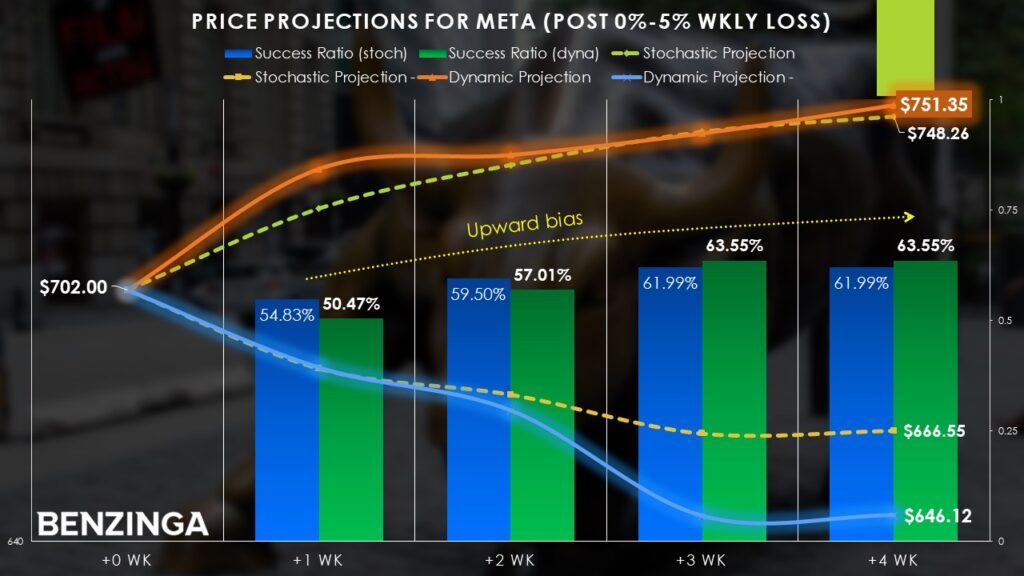Zinger Key Points
- Social media and technology juggernaut Meta Platforms saw its 20-day win streak getting snapped.
- Nevertheless, history demonstrates that investors tend more often than not to buy the dips.
- Markets are swinging wildly, but for Matt Maley, it's just another opportunity to trade. His clear, simple trade alerts have helped members lock in gains as high as 100% and 450%. Now, you can get his next trade signal—completely free.
All good things must come to an end and the same goes for celebrated innovators, including social media and technology giant Meta Platforms Inc. META.
Earlier, Meta stock contributed handsomely to the record-breaking surge in the Nasdaq-100, thanks in large part to its relentless rise. However, Tuesday ended the security's run of 20 consecutive trading sessions in the black.
Until that point, Meta stock had soared 16% since Jan. 16, contributing to the Nasdaq's rise. In addition, its heavy weighting in the Invesco QQQ Trust QQQ and other exchange-traded funds boosted their market value. Not surprisingly, artificial intelligence continues to represent a key catalyst for Meta's upswing.
Still, not everything has been smooth sailing. Fundamentally, concerns center on employee criticisms of the company's latest layoffs. On the technical front, certain indicators demonstrated that Meta stock was overbought. If that wasn't distracting enough, CEO Mark Zuckerberg offloaded 17,855 shares of Meta's Class A common stock totaling around $14.4 million.
However, the latest regulatory filings revealed that activist investor Dan Loeb's Third Point LLC had significantly boosted its investment in Meta stock during the final quarter of 2024. Subsequently, the move brings the security to its top four list.
Following Meta's impressive results for its fourth-quarter earnings report — delivering earnings per share of $8.02 on sales of $48.39 billion (both beating consensus targets) — multiple analysts raised their price forecasts. Currently, Wall Street's consensus price target stands at $731.76, with a high-side estimate of $935.
Traders Gravitate Toward The Dips
Moving forward, a critical advantage that bullish speculators enjoy is that Meta stock naturally features an upward bias. For example, using pricing data extending back to January 2019, a position entered at the beginning of the week has a 54.83% chance of rising by the end of it. Notably, the long odds improve to 62% over a four-week period.
At the same time, using baseline probabilities can be challenging from an assessment point of view. Arguably, it's more important to focus on relevant data; that is, data that harmonizes with the current or prevailing market trend. That's the key difference between analyzing information stochastically (or temporally) versus dynamically.

At the present juncture, Meta stock is on track to lose about 4.5% this week. Historically, when Meta loses up to 5% in a one-week period, the subsequent week only has about a 50/50 shot of rising. This circumstance may be due to investors digesting the volatility that just materialized. However, over the subsequent four weeks, the long odds rise to 63.55%.
Put another way, over time, the upward bias becomes evident again. While this framework doesn't guarantee trading success, it shows that enthusiasm is consistently strong for Meta stock, even if it tumbles every now and then.
The Red Ink Offers a Silver Lining
For the bargain hunter, the red ink in Meta stock offers a silver lining: call options have been cheapened relative to how they were priced just days ago. This means speculators can acquire high payout transactions that arguably feature rational probabilistic risk.
Following a modest weekly decline in Meta stock, the median four-week return under the positive scenario comes in at 7.03%. Based on an estimated closing price of $702, that would assign an upside target of $751.37. Fortunately, there are plenty of big payout trades that don't require such a leap in market value.
For the options chain expiring March 14, bullish speculators may consider the 710/715 bull call spread. This multi-leg strategy involves buying a call ($710) and simultaneously selling a call ($715). Primarily, the idea is to use the credit received from the short call to partially offset the debit paid for the long call, thus discounting the net long position. Should the security rise to or above the short strike price, the trader collects the maximum reward (a payout of around 108%).
To be clear, bull spreads are capped-risk, capped-reward transactions. The trader can't lose more than the debit paid (since the lower-priced long call offsets the potential obligation of the higher-priced short call). On the other hand, the trader can't gain more than the maximum reward.
Speculators could choose to raise the short leg and adjust the long leg as necessary to potentially achieve a higher payout. However, doing so would increase the probabilistic risk of the trade not being profitable. With the aforementioned trade, Meta stock only needs to rise less than 2% by expiration to collect a big payout.
Now Read:
Image: Shutterstock
© 2025 Benzinga.com. Benzinga does not provide investment advice. All rights reserved.
Trade confidently with insights and alerts from analyst ratings, free reports and breaking news that affects the stocks you care about.